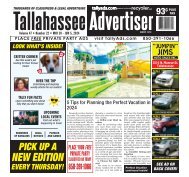050120_layout_AllPages
Create successful ePaper yourself
Turn your PDF publications into a flip-book with our unique Google optimized e-Paper software.
THETRUCKER.COM<br />
b Safety from page 20 b<br />
applying the brakes. A thinking driver can recognize<br />
that a vehicle far ahead is traveling at<br />
a slower pace and can adjust speed or change<br />
lanes before it becomes a hazard. A thinking<br />
driver can identify that a passing vehicle is<br />
likely to cut in front and prepare for it, adjusting<br />
speed or changing lanes before hitting the<br />
brakes hard becomes necessary. A thinking<br />
driver knows that a ball rolling in the road is<br />
often followed by a child chasing after it.<br />
Be that thinking driver.<br />
Use available technology to help make the<br />
job safer and easier, but never let it replace<br />
sound safety practices. Use the safety knowledge<br />
you have accumulated to make corrections<br />
BEFORE the computer decides or the warning<br />
system alerts. Keep your speed appropriate for<br />
conditions. Maintain a safe following distance.<br />
Be aware of what’s happening, far ahead and<br />
all around your vehicle. Communicate your<br />
presence and your intentions. Anticipate the<br />
actions of others<br />
You know how to be the safest driver you can<br />
be. Never let a computer do that for you. 8<br />
b Plummet from page 17 b<br />
Reefer rates fell to $2.09 per mile but rose to<br />
$2.19 in March.<br />
The good news was short-lived, however.<br />
The increases in shipments of household products<br />
could not offset the shipments lost due to<br />
shutdown of manufacturing and service outlets<br />
for a sustained period. Shipment numbers must<br />
fall and, when they do, rates fall with them.<br />
The process has already begun.<br />
“We have started to notice price degradation<br />
in the dry van and reefer segments, likely driven<br />
by heavy contraction in demand,” said Adamo.<br />
“The load-to-truck ratio, the number of loads<br />
posted with our service compared to the number<br />
of trucks looking for loads, has been decreasing<br />
steadily. We’re definitely seeing it impact rates.”<br />
In the first week of April, spot rates for van<br />
fell by 2 cents per mile, while reefer rates lost<br />
10 cents. That’s just the beginning.<br />
“I think from a demand perspective, we’re<br />
going to do more than correct,” Adamo predicted.<br />
“I’m starting to think we’ll see a steep<br />
drop-off.”<br />
A part of that drop off is due to Chinese<br />
freight.<br />
“Nearly two months after shutting down for<br />
the Spring Festival holiday, China is only now<br />
starting to return to work,” said Kenny Vieth,<br />
president and senior analyst at ACT Research,<br />
in an April 3 release. “Domestic port and rail<br />
volumes have just begun to reflect the drop in<br />
Chinese output.”<br />
A big reason for concern about port and rail<br />
volumes is Christmas.<br />
“Remember that stocking up for the holiday<br />
season begins right around this time of year,”<br />
Business May 1-14, 2020 • 21<br />
ATRI data shows decline in April trucking due to stay-at-home orders<br />
THE TRUCKER NEWS SERVICES<br />
ATLANTA — The American Transportation<br />
Research Institute has released new data that<br />
quantifies the continued impacts of COVID-19<br />
business disruptions on the trucking industry.<br />
ATRI’s latest analysis looked at truck activity<br />
across six states from Feb. 9 through<br />
the week ending April 18, by converting<br />
its real-time truck GPS dataset into a truck<br />
activity index.<br />
“The GPS data we use is a valuable tool<br />
into what is going on in the economy and the<br />
trucking industry right now,” said ATRI President<br />
and COO Rebecca Brewster. “We knew<br />
from talking to drivers and carrier executives<br />
that there were significant impacts on operations<br />
as a result of COVID-19, but now, by<br />
analyzing this data we are able to put numbers<br />
and data to feelings and anecdotes.”<br />
From early February into March, the data<br />
shows a spike in initial truck activity in the<br />
analyzed states — documenting the response to<br />
high consumer demand for items such as nonperishable<br />
food and paper products, as well as<br />
the much-needed emergency medical supplies.<br />
The analysis further documents the<br />
iStock Photo<br />
There are some signs of a return to normalcy in ATRI’s data as truck activity has seen an<br />
uptick around New York City in mid-April.<br />
impacts of the stay-at-home orders that shut<br />
down major segments of the economy, with a<br />
resulting decline in April trucking operations.<br />
Of the six states analyzed, California had the<br />
earliest stay-at-home order issued on March 19.<br />
California also experienced the earliest upward<br />
spike in truck activity, occurring during the week<br />
of March 1. However, truck activity in California<br />
is now down 8.3% from early February.<br />
In Florida, Illinois and New York, truck activity<br />
spiked the week of March 8 but is now<br />
down on average by over 10% from Feb. 9.<br />
In Pennsylvania and Washington, truck<br />
activity spiked during the week of March 15,<br />
Adamo explained. “Retailers are deciding now<br />
how many Xboxes they will stock for Black<br />
Friday and placing orders accordingly.”<br />
In an economy that’s long overdue for a<br />
recession, the impact of the COVID-19 pandemic<br />
will reach far beyond public health. Recession<br />
is a real possibility.<br />
“Everyone is nervous. We’re definitely<br />
looking at recessionary pressure, but is it a ‘V’<br />
or a ‘U’ shape?” said Adamo, referring to economic<br />
activity in graph form, wondering if it<br />
will fall quickly and rebound just as quickly,<br />
the “V” shape, or remain low for a while before<br />
rebounding, the “U” shape.<br />
Adamo has some advice for small trucking<br />
businesses who depend on loads from the spot<br />
market.<br />
“Information changes fast,” he said “Use<br />
technology to get the latest. For example, (spot)<br />
rates grew 10% from the end of February to<br />
but is now down by an average of nearly 9%<br />
from Feb. 9.<br />
There are initial signs of a return to normal,<br />
however. In New York, one of the earliest<br />
states to experience high numbers of cases,<br />
truck activity started a positive uptick during<br />
the week of April 12.<br />
“In these unprecedented times, we need to<br />
rely on science and facts, not anecdotes and<br />
speculation. This ATRI research is able to tell<br />
us in near-real-time what the pandemic is really<br />
doing to the trucking industry,” said American<br />
Trucking Associations Chief Economist<br />
Bob Costello. 8<br />
mid-March. Did your broker tell you, or offer<br />
the same rate and keep the difference?”<br />
DAT’s load board, the industry’s largest,<br />
provides up-to-the minute load information,<br />
while the service’s “Trendlines” page provides<br />
useful planning information.<br />
“Be smart about rates,” Adamo continued.<br />
“Make the best decision using the best tools.”<br />
Efficiency is important, too. Adamo counseled<br />
avoiding 300-mile deadheads to load backhauls,<br />
adding, “think in terms of lanes. A load with a<br />
good rate doesn’t help if it puts you somewhere<br />
that you lose money on the return trip.”<br />
A good relationship with a broker is another<br />
way to keep the wheels turning profitably, he said.<br />
“Most importantly,” Adamo concluded,<br />
“thank a trucker. These are extraordinary times.<br />
It’s very important to thank drivers and provide<br />
them with the recognition they deserve. They are<br />
saving a nation.” 8<br />
ALL THINGS TRUCKING<br />
News Gears Reviews Demos Rig Report How-to’s Trade Shows<br />
@truckbossshow

















